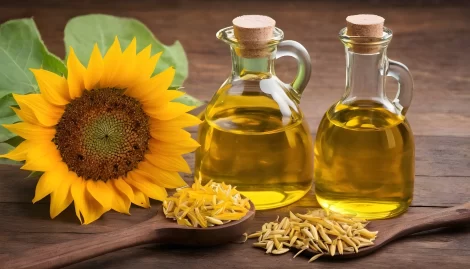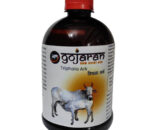Subtotal: ₹400.00
The sunflower is actually a group of hundreds of small blossoms rather than a single flower. Steam extraction is the method used to extract the oil from the seed. Sunflower oil has a mild flavor and works well for baking and frying as a culinary oil. Vitamin E level in sunflower oil is higher than in any other vegetable oil, even safflower oil.

Its mild flavor, excellent frying ability, and health advantages make sunflower oil highly sought after. NuSun, linoleic, and high oleic sunflower oil are the three varieties of sunflower oil that are available. They’re all created using conventional breeding methods. Their oleic levels vary, and they all have different qualities.
The seeds of the safflower plant are used to make safflower oil.
High-linoleic and high-oleic safflower oil are the two types that are offered. High-oleic safflower oil has a higher concentration of monounsaturated fats than high-linoleic safflower oil, which is higher in polyunsaturated fats. High-oleic safflower oil is the variety that is more widely available on the market. It is used as a frying oil that holds heat well, particularly for fried meals like chips and French fries.
This is due to the high smoke point of safflower oil, which is around 450°F (232°C). In actuality, safflower oil smokes at a higher temperature than other widely used oils like canola oil.
Steam extraction is used for obtaining safflower oil from the seed. Two types of safflower oil exist. One type is high in polyunsaturated fatty acids and is called linoleic. The other is a monounsaturated fatty acid-rich oleic variant. Saturated fat content is extremely low in both types. Safflower oil is less saturated and more monounsaturated than olive oil, but it still can’t compete with sunflower oil.
Most of the safflower oil that is now on the market is high oleic safflower oil. This lipid composition and oil characteristics are comparable to those of high oleic sunflower oil.
While it is available in small quantities, a high linoleic variant of safflower oil is extremely uncommon in the food business and somewhat more commonly used in skin care and medications.
Monounsaturated fats are present in high oleic safflower oil, but polyunsaturated fats are more prevalent in high linoleic safflower oil.
Similarities Of Safflower oil vs Sunflower oil
Both Safflower oil vs Sunflower oil oils are fairly similar in terms of composition, properties, and how they work in a product. This is very true—you are likely to find the phrase “high oleic expeller pressed safflower or sunflower oil” written on the back of natural chips. These oils are often employed alternately in recipes.
Here are some similarities between the two oils:
Light in color
The color of both safflower and sunflower oils is light yellow. Since they are both refined, they don’t have as much color as olive oil and remain quite consistent over time.
Have mild flavor
These two oils are also mildly flavored. Since they are both refined, the high heat procedure eliminates most of the flavor. This indicates that your product won’t taste particularly flavorful from either oil.
Same price point
These two oils have almost identical pricing points. This is due to the fact that the oils are manufactured using essentially the same processes and are frequently used interchangeably, meaning that supply and demand are contingent on the other oil.
There will be years when high oleic sunflower oil is less expensive and years when high oleic safflower oil is less expensive. However, they are remarkably similar overall.
What are the differences between Safflower and Sunflower oil
Even though these oils have many important characteristics, they also differ in some important aspects.
Different plants
Yes, the sunflower plant from which you collect sunflower seeds for baseball season is also the source of sunflower oil. You can arrange this plant in a vase on your table.
The source of safflower oil is a thorny, stalky plant with tall, spiky, colorful blooms that grows in arid environments. The seeds that are found inside the bulbs beneath the flowers are what are used to make the oil.
Varieties of sunflower
Three varieties of sunflower oil are commonly available: high oleic, mid oleic, and linoleic, which is also referred to as “classic” sunflower oil. The mid-oleic and linoleic types are produced in significantly bigger quantities worldwide, although the high oleic variety is commonly found in the natural food business. Traditional sunflower oil, also known as linoleic oil, is really rather widely available in cheap retail bottles, particularly in other nations like India, Africa, and the Middle East.
Price points
Remember that the costs of each oil are comparable only for the high-oleic versions. Large amounts of a more affordable linoleic variant of sunflower oil are also produced; this variation will be far less expensive than the high oleic varieties of both sunflower and safflower.
High supply of sunflower oil
Sunflower oil is a lot more commonly used oil worldwide. This indicates that it is produced in greater quantities and has been a preferred option for a longer period of time. Sunflower will be the best bet if you’re seeking extremely high volumes.
Comparison of supply and production
Kazakhstan produced 24% of the 718,161 tons of safflower seeds produced worldwide in 2013. Mexico, Argentina, the United States, and India were other major producers. According to the FAS, the world produced 14.98 million MT of sunflower oil in 2014, with over half of that amount coming from Russia and Ukraine.
The organic varieties
Since most consumers shopping for organic variants also search for the healthiest sort of oil, organic high-oleic sunflower and safflower oils are the most popular organic oils. Although they are far less common, organic mid-oleic and organic linoleic sunflower oils are also available.
Safflower oil vs Sunflower oil Which one is healthier?
Safflower oil is lower in calories and fats, to begin with. Additionally, it provides a lot of protein, while sunflower oil has none.
In terms of minerals, sunflower oil is devoid of all of them, but safflower oil is abundant in phosphorus, potassium, sodium, calcium, iron, magnesium, zinc, and copper. Furthermore, sunflower oil contains zero of the vitamins A, B1, B2, B3, B5, B6, and folate that are abundant in safflower oil.
The last essential amino acids are found in safflower oil, whereas sunflower oil lacks tryptophan, methionine, phenylalanine, valine, threonine, isoleucine, leucine, lysine, and histidine.
Sunflower oil has one major negative health effect. Sunflower oil has the potential to release compounds known as aldehydes that could be harmful to human health when it is repeatedly heated to high temperatures.
Aldehydes are hazardous substances that can harm cells and DNA, which can exacerbate conditions like Alzheimer’s and heart disease.
More aldehydes get released into the air when sunflower oil is heated for a prolonged period of time. It may therefore be safer to use sunflower oil for sensitive, low-heat cooking methods like stir-frying.
Summary
If you’re searching for a virtually identical replacement for safflower oil, your best bet is sunflower seed oil. This is reciprocal.
Although they come from separate plants, sunflower and safflower are members of the same family and are used to make oil from them. It is difficult to discern between the two oils. They offer neither color nor flavor to foods and are a vivid yellow color. As a result, they make excellent replacements for one another.
Sunflower seed oil has a slightly lower smoke point than safflower oil, at 450°F (232°C). Remember that sunflower oil tends to produce aldehydes when heated at high temperatures. Therefore, it might be safer to use sunflower oil instead of safflower oil while cooking with moderately low heat, such as stir-frying.
Many popular dishes, such as vegan safflower butter or homemade sunflower mayonnaise, are based on safflower oil or sunflower oil.
However, some recipes don’t specify which oil should be used. Additionally, in contrast to common perception, experimenting with sunflower and safflower oil occasionally delivers a dish that is absolutely delicious.

